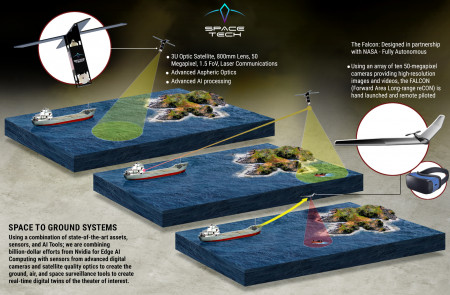Shipping Captains Receive Space Security

FORT MYERS, Fla., December 23, 2022 (Newswire.com) - Piracy is still an issue in modern times, with criminal groups using advanced equipment and tactics to attack commercial vessels in waters around Africa and Asia. These attacks involving the robbery and ransom of ships cost between $13 and $16 billion annually. The actual number of attacks is unknown due to underreporting by shipping companies, which may be concerned about insurance premiums. While some measures, such as escorts and onboard security, have been taken to protect vessels in high-risk areas, using weapons for self-defense remains controversial due to international treaties.
"Sadly, captains on shipping vessels are typically left alone with little to no support during piracy events; our answer is the FALCON." - Wil Glaser, Space-Tech CEO
FALCON (Forward Area Long-range reCON) leverages 2023 technology for sensors, processors, and UAV control. FALCON provides advanced scanning and surveillance at an affordable price in an asset that can be launched, operated, and recovered without sophisticated equipment or trained specialists.
With advanced satellite quality optics, images from over 1 kilometer away are broadcast to the Augmented Reality HMD, allowing the user to control the mission with simple voice menu commands, eliminating the joystick controller. A single operator can hold a dozen units remotely, allowing a fleet of Falcon drones to cover an entire theater or fire threat region, creating a real-time map of fire spread or providing radar and visual surveillance over open waters.
Space-Tech SAGS Service (SPACE-TO-GROUND SECURITY) blends its satellite platform & FALCON with a combination of state-of-the-art assets, sensors, and AI Tools.
Space-Tech combined billion-dollar efforts from Nvidia for Edge AI Computing with sensors from advanced digital cameras and satellite quality optics to create real-time digital twins of the theater of interest.
A peek inside shows an impressive build of materials like a GPS, Radio, Acoustic, Radar, LIDAR, and vision sensors on board with an AI object or threat recognition tool to report if threats are detected, minimizing operator radio bandwidth and tasking. Communications and video links can be encrypted and broadcast over RF, WiFi6, and 5G communication channels.
Missions include perimeter security, surveillance, search and rescue, and 3D Terrain Mapping. Intelligence can be relayed to the base and coordinated with the ground or other assets.
Constructed out of lightweight advanced Carbon / Graphene Composites, the Autopilot allows selected missions to be programmed to enable forward deployment without needing a trained operator. A local technician would launch it into the air and swap batteries as needed, but the piloting is 90 percent AI and 10 percent remote expert.
For reservations and pre-orders for this service, click here.
Source: Space-Tech
